Photo

Japan’s Type Kō rifle in testing
In the early 1930s, the Imperial Japanese Army created a requirement for a self-loading rifle in military service. Several companies were commissioned to develop experimental rifles for comparative trials, including Nittoku Special Steel, Tokyo Gas & Electric, and the state controlled Tokyo Arsenal. The efforts of Tokyo Arsenal appear to have been headed by Saburo Watanabe and Hayahiko Mihara. By 1933, their rifle - known as the “Type Kō” - was ready and a small batch of prototypes were made, with several variances in design (including barrel lengths, magazines, and pistol grips).
The Type Kō was essentially based on the Vickers-Armstrong Pedersen rifle and employed a copy of that rifle’s toggle-lock mechanism. This was not a recoil-operated toggle action in the style of the Luger, but instead a blowback-operated weapon with a fixed barrel. It fed from an internal 10-round rotary drum magazine, somewhat similar to that of the later Johnson M1941 rifle. The chambering was for the standard 6.5x50mmR Arisaka rifle cartridge.

Early Japanese patent depicting a Pedersen-style toggle action rifle.
In 1935, Tokyo Arsenal was merged with Kokura Arsenal and all work on the Type Kō rifle was transferred to Kokura. That same year, the Type Kō was tested against the Type Otsu and Type Hei rifles by Tokyo Gas & Electric and Nittoku Special Steel respectively. Rigorous military trials exposed flaws in all the rifles; in addition, the projected costs of adopting a self-loading rifle were too high and so the IJA cancelled the project entirely. Japan fielded no self-loading rifle during World War II, only deciding to produce such a weapon at the very end of the war with a copy of the M1 Garand known as the Type 4, which never made it to the front. When the Americans occupied Japan in 1945, they found and confiscated self-loading rifles from military arsenals. Most were destroyed, however some were preserved and were taken to the US, where a few examples of the Type Kō exist today.
Photo found by national police reserve 1956
26 notes
·
View notes
Photo

Stocked Villar Perosa
At some point or another, you may have seen photos floating around the internet of Villar Perosa submachine guns fitted with rudimentary wooden buttstocks. These are often claimed to have been the result of the Italians realizing the potential of the Villar Perosa as an assault weapon and attempting to adapt it to a shoulder-fired role. This was not exactly the case. When the Villar Perosa was first introduced into combat in April 1916, it was issued with a large metal shield and was intended to be fielded as a crew-served light support weapon. By the end of 1917, the Italians ditched the shield in favour of a lighter and less obstructive bipod. At the same time, they were experimenting with ways to use the Villar Perosa in a ‘marching fire’ role, particularly among the newly-raised Arditi corps. The solution that was eventually settled on was the rather comical ‘cigarette girl’ method which saw the user wear the weapon on a wooden tray that was strapped around their chest.

Wooden tray mount for the Villar Perosa, adopted by the Arditi in 1918.
Italy’s adversary Austria-Hungary raised their own assault units, the Sturmbataillons, around the same time. As soon as they were founded, these battalions adopted the practice of issuing captured Villar Perosas to their troops. In October 1917, the Austrians adopted a 9x23mm copy of the Villar Perosa, known as the Sturmpistole, which was fielded in action at Caporetto but proved to be of poor reliability; additionally, they were produced at a very slow rate. Captured Villar Perosas continued to be issued, and in 1918, the Austrians came to the same conclusion as the Italians - that the Villar Perosa could be adapted into an off-hand weapon for assault use. But the method by which they achieved this was very different. Rather than a flat tray, they mounted them on the aforementioned wooden shoulder stocks, which were, in fact, an Austrian invention and not an Italian one.
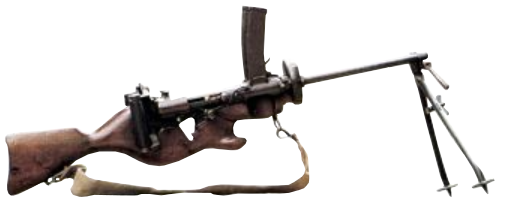
Austrian-service Villar Perosa with wooden buttstock and bipod mount.
Since the Villar Perosa’s twin spade grips were retained and no effort was made to adapt the trigger mechanism to fit the stock, the method of wielding this weapon was awkward; the user place one hand on the forward grip and the other on one of the triggers, while pressing the stock against their shoulder. It was not a perfect solution but it did demonstrate a basic understanding of the submachine gun concept by the Austro-Hungarians, and could be said to be the first “true” SMG that the Austrians ever fielded.
The number of Villar Perosa shoulder stocks produced by the Austrians is not known, but seems to have only been a very limited amount. Surviving examples can be seen today in museums in Italy and Austria.
79 notes
·
View notes
Photo

Unusual Mannlicher 1888 self-loading conversion
This rifle was an attempt to convert the Austrian Mannlicher 1888/90 bolt-action rifle into an automatic gun. The provenance is entirely unknown and there are no markings to indicate who the conversion was done by, or when it was made. It is highly unlikely to be a product of the ŒWG factory in Steyr, or anything to do with Ferdinand Mannlicher; it has also been suggested that it originates from the Netherlands, although according to the Dutch expert Bas Martens, this is not the case. The Mannlicher 1888 rifle was so widely used around the world that it is difficult to associate this gun with any one country. It may be Bulgarian, Greek, Russian, or even Chinese in origin. The only known record of a similar Mannlicher 1888 conversion was a Polish gas-operated design that appeared in the 1920s, known as the DOG rifle, although that was a far more competently-made weapon than the rifle shown here.
A somewhat likely candidate for the designer of this conversion is the Russian engineer Yasnikov who was the Master Armourer at the Tula Arms Plant during World War I. Yasnikov designed a gas-operated conversion of the Mannlicher 1895 rifle which appears to have been similar in design to this Mannlicher 1888/90 conversion, albeit a little more refined. It is possible that the 1888/90 conversion was an earlier and more rudimentary attempt by Yasnikov to develop a Mannlicher-based automatic rifle.

This conversion was almost certainly made by hand, as the standard of the added components, such as the gas piston and bipod, are poor. The bipod does not stow and simply hangs on a loose hinge underneath the barrel. It is very crudely made from cast metal. The gas tube recedes into the fore-end of the stock and reaches to the barrel. The exposed section of the gas tube houses the piston which engages the bolt. There appear to be no extra frills to this design and it is one of the most basic gas-operated conversions I have ever seen. The stock has been fitted with a small pistol grip which, while quite unergonomic, is a sensible feature as it removes the user's hand from the stock and prevents their thumb from being snagged by the bolt as it reciprocates. Additionally, a rather flimsy stop plate has been screwed to the cheek rest, which hinges up to protect the user's face from being struck by the bolt - although the structural integrity of this plate is somewhat questionable.

The floor plate of the Mannlicher magazine has been removed and the hollowed-out magazine has been reconfigured to act as a feed housing, taking a rudimentary extended magazine (not pictured) which appears to have been fashioned from an existing magazine, probably from a light machine gun or automatic rifle. The magazine has two large, circular cut-outs on the left side which allow the user to check the cartridges as they sit in the magazine, but also make the bullets susceptible to dirt and fouling. The addition of an extended magazine capacity and bipod may imply that this weapon is designed to fire automatically, like a machine gun.
Hopefully more information about this rare conversion will come to light in the future.
38 notes
·
View notes
Photo

A well-travelled MAS 38 prototype
Recently I got the chance to examine and photograph this French submachine gun, which has a very interesting provenance.
Although it appears at first glance to be a standard MAS 38 submachine gun, the standard French service SMG of the 1940s and 50s, it’s actually marked Type SE-MAS 1935 F 1537. This denotes that it was an earlier trials model of the MAS 38 that was produced before its official adoption in 1938. It was selected for service in favour of the Thompson, MP 28,II, and Type ETVS submachine guns, but was not issued in any significant quantities before the German invasion of France in 1940, and during World War II it was predominantly only issued to internal Vichy forces.
This example of the SE-MAS 35, however, appears to have travelled across several different countries in just the first year of the war. The wooden buttstock is marked with several different locations that its owner seems to have passed through, taking this gun with him. The first is “Dęblin”, which is a town in Poland that, in 1939, housed both an an ammunition depot, and an air force training school. Additionally, the Main Arms Warehouse No.2 was located just 8km outside of Dęblin, which provides a probable location of origin for this gun. This gun was probably sent to Poland for trials in the late 1930s, and was issued on an emergency basis to a Polish airman or soldier who was stationed in Dęblin in 1939.

The second location is marked “București”, which is Bucharest, the capital of Romania. Poland shared a border with Romania in 1939, and when Poland fell to the Germans, some 120,000 Polish troops fled to Romania, which sufficiently explains the second step of this story.
Next is “Paris”. Our hero would have ended up there during the attempts to reorganize the remnants of the Polish Army in allied France. Following Paris is “Lyon”, and then “Andrézieux” (which I assume is Andrézieux-Bouthéon?), and then “Port-Vendres”, a port in southwest France from which this soldier probably sailed through the Strait of Gibraltar to Portugal after the Fall of France in June 1940. Neutral Portugal acted as a point from which Free French and Polish refugees fled to Britain, and this is made evident by the next marking: “St. Vincent”, referring to Cape St. Vincent on the southern Portuguese coast.
Our hero then ends up in Britain, where he stays first in “Liverpool”, then “Kirkham”, and then finally in “Bramcote”. Bramcote was home to a Royal Air Force base during the war, which was probably where this soldier was stationed after joining the Polish Forces-in-Exile. After this, he simply marks the end of the stock with a “?”, indicating that he has no inclination as to where the war will take him next, but that it it is bound to take him somewhere new. Unfortunately, no other locations are given, although I don’t know whether this is because he was stationed in Bramcote for the rest of the war, or whether it’s just because he ran out of space on the stock.
It’s worth noting, however, that this gun only ended up in a museum after being voluntarily surrendered to the police during the 1988 Firearms Amnesty, which means it remained in private hands even after the war had ended. Did the same man keep hold of it for almost six decades?
I’m sure this unidentified soldier had many stories to tell!
79 notes
·
View notes
Photo

The Steyr M.1912/P16 machine-pistol
This weapon was reportedly commissioned at the end of 1915 and developed at the Österreichische Waffenfabriksgesellschaft under the direction of Major Franz Xaver Fuchs, commander of Standschützen-Bataillon Innsbruck II. Major Fuchs was, curiously, a painter by trade, not an engineer. Prior to the war, he tutored at the Franziskanergymnasium in Tyrol. Interestingly, another Standschützen officer - one Herr Hellriegel - also developed a submachine gun-type weapon that was tested in Tyrol in late 1915, implying that there was some interest in machine-pistols and SMGs within Tyrolean Standschützen regiments in particular. The exact reason for this is not entirely known although it is likely that they realized from an early date that light automatic weapons would be required in an alpine conflict with Italy.
The M.12/P16 machine-pistol was an automatic conversion of the standard Steyr M.12 service pistol, and the operation was unchanged, incorporating a short recoil action in which the barrel and slide recoiled together until the barrel was forced into a 20° rotation by two locking lugs until the slide returned forward. The only technical difference between the standard M.12 and the M.12/P16 was the addition of a fire selector switch which allowed uninterrupted automatic fire, situated on the right side of the trigger group. The selector mechanism basically consisted of two 'arms' - a long 'arm' which was the selector switch itself, and a short 'arm' which acted as a trigger link - both pinned to the trigger group by connecting screw. The screw passed through the selector switch first, the trigger link second, and the lastly the trigger itself. The bottom of the trigger link was itself pinned to the trigger piece. When the selector switch was flipped up, the screw would turn and drag the trigger link backward, which in turn would place pressure on the trigger itself and hold the sear down. Thus, when the trigger was pulled fully, the pinned-down sear would be prevented from interrupting the action. This gave an automatic fire rate of about 800 rounds per minute.

By February 1916, a batch of 50 prototypes were delivered for field trials and were issued to Major Fuchs' battalion. These early models fed from the M.12's standard 8-round internal magazine and, against a firing rate of 800rpm, they could only fire off a short burst or two before depleting. This was somewhat remedied in the full production model, which extended the internal magazine to 16 rounds - an improvement, but still less than ideal. Topping off the magazine, either by feeding two 8- round clips or manually loading each cartridge by hand, was also slow and cumbersome compared to a detachable magazine feed. It is because of this extended magazine that the weapon earned its "P16" suffix, standing for Patrone 16 ("16 cartridges") - contrary to some reports, "P16" is not in reference to the year 1916.
After a successful trial phase, the M.12/P16 was accepted into service, reportedly with an order of some 5,000 units being placed. They were issued exclusively on the Italian Front, to bolster the firepower of Tyrolean regiments fighting in the Alps. It is not known whether they were actually fielded as trench-clearing assault weapons as is commonly assumed; Austria in 1916 was fighting a mostly defensive war against the Italians, and there is no indication that the weapon was commissioned for use by shock troops, although it is certainly possible that they were issued to some Sturmbataillons in 1917.

As evidence of the Villar Perosa's influence on Austrian submachine gun concepts, a contraption was developed for the M.12/P16 known as the Doppelpistole ("double-pistol"). This was simply a double mount that fitted two M.12/P16s to a central wooden buttstock in an attempt to make it "double-barrelled". A wooden carrying case, similar to that issued with the Villar Perosa, was also made for the Doppelpistole, although the idea seems to have been experimental and never came into wide issue. It may have been intended as a fixture for aircraft.
The M.12/P16 remained in service throughout the war, and was apparently produced in surprisingly large numbers. An inventory taken in Tyrol at the end of the war reported some 9,873 units in issue. In spite of this, the physical evidence for such a large number having been produced is scant. Only a handful of examples exist today, most of which are low serial numbers, leaving some experts to have estimated that less than a thousand were made (Thomas Nelson claimed around 900). It is possible that most examples were destroyed by the Inter-Allied Commission after World War I, but this is merely speculation. The associated patent for the fire-selector was finally approved in December 1919, having been applied for three years earlier, although there is nothing to suggest that the weapon was ever produced again after the armistice. Claims that M.12/P16 machine-pistols were rebarreled in 9x19mm Parabellum and issued with silencers to Abwehr commandos in World War II are unverified.
Article originally posted here: http://firearms.96.lt/pages/Steyr_M.12_P16.html
92 notes
·
View notes
Photo

Maefassi self-loading rifle
This rifle was reportedly designed by an Italian officer, Carlo Maefassi, while stationed in Addis Ababa, Ethiopia, in 1939. It was essentially a gas-operated conversion of an old 8x56mmR Steyr 1895 rifle, with an underbarreled gas piston and a long bolt rack. The stock was modified with a pistol grip. The history of this weapon seems to be obscure and not well documented, although the rifle has survived and is currently housed at the Beretta Museum in Gardone Val Trompia.
41 notes
·
View notes
Text
No, but I can rattle them off real quick for ya:

Moschetto Automatico Revelli (or OVP submachine gun)
This was the earliest concept of a single-barreled, shoulder-fired Villar Perosa, developed for a commission by the Air Artillery Department to replace the Mauser C96 as a self-defence weapon for pilots and aerial observers. The first prototype was tested in December 1916 and seems to have an inverted magazine feed with the mag loading in the underside of the receiver, but the production models had a top-loading mag. You’ll sometimes hear people say that these were issued to infantry assault troops; the only evidence I can find indicates that they were issued exclusively to pilots and were never used by infantry. Sometimes claimed to be a “conversion” of the Villar Perosa, but actually they only have a bolt and magazine in common - practically all other components of the OVP are original. Only about 500 were produced, probably from around 1917 - 1918.
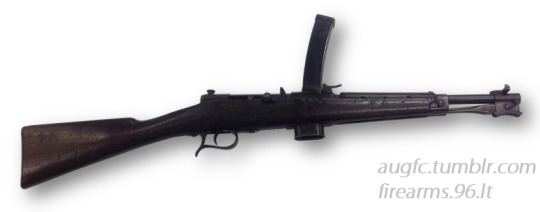
Moschetto Automatico Revelli-Beretta (or Beretta Model 1918)
Probably the most well-known adaptation of the Villar Perosa, thanks to Battlefield 1. However BF1′s depiction of this gun (and indeed most written descriptions) are totally incorrect as this was NOT a submachine gun but a self-loading carbine. Essentially this gun is a hodgepodge of recycled features from other weapons. The receiver is repurposed from one half of a Villar Perosa, the stock is from a Vetterli rifle and the folding bayonet is borrowed from the Carcano M91 cavalry carbine. Beretta received a contract from the Italian Army to convert 5,000 Villar Perosas into 10,000 Revelli-Beretta carbines in September 1918 but the war ended soon afterward and it’s not known whether any were actually used in combat. The contract was cancelled in 1920 after only 5,000 had been delivered.
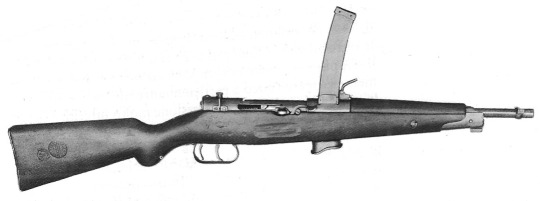
Moschetto Automatico MIDA
This is essentially a variant of the Beretta 1918 carbine produced by Manifattura Italiana d'Armi (MIDA) at the end of World War I. Unlike the Beretta gun, this is genuinely a submachine gun as it had two triggers, one giving automatic fire and one giving single shots. Although the MIDA gun is based on the Beretta, it doesn’t share any components except the bolt and magazine; practically everything else is different, right down to the magazine catch and ejection chute. Only small numbers of these guns were made, and were probably never issued.

Moschetto Automatico Crocetti (?)
This one’s a bit uncertain, the information I originally read stated that it was designed by Revelli in 1916 and produced as part of a collaborative effort between OVP and FIAT (OVP was a subsidiary of FIAT during WW1). However I contacted the curator of the Italian museum collection which it’s currently housed in, and he only said that it was believed to be by Revelli. After looking further into it, it seems that the Revelli gun tested in 1916 was an early iteration of the OVP model, so I’m not sure where this gun fits into the timeline. However, it seems to match the description of a lesser-known SMG prototype produced by Ansaldo in 1918 known as the Ansaldo Crocetti. The Crocetti submachine gun was trialed but rejected in favour of the Beretta carbine.

Moschetto Automatico Revelli-Beretta-Pavesi
This is basically a Beretta carbine restocked and converted into full-auto, fitted with a pneumatic piston connected to the bolt, known as the Pavesi device. These were designed to be fitted to Villar Perosas to reduce the fire rate to a controllable level (apparently around 300rpm). Unlike the standard Beretta, this is genuinely a submachine gun, but it was only made as an experimental model and was never adopted.

Moschetto Automatico Revelli-Beretta (inverted)
Nothing much to say about this one except it’s a Beretta carbine with its receiver inverted on its head, so the mag feeds in the bottom and the spent cartridges eject out the top. A byproduct of this conversion is that the cocking slot is now located on the left side of the gun. Experimental only; never produced.

Moschetto Automatico Revelli-Beretta (fire selector)
A restocked and reconfigured version of the Beretta carbine with a fire selector switch for automatic and single shots. Probably produced at MIDA in late 1918. Again, only experimental and never adopted.
There are a few others that seem to be lost to time:
Moschetto Automatico A.N.
Probably made by the Aviazione Navale on commission of the Air Artillery Department. I’ve seen a photo of a Villar Perosa-based SMG that might be the A.N. model, with twin triggers and a sporter-style stock which looks like it was designed for aerial issue. The A.N. submachine gun was not adopted.
Moschetto Automatico Savoia
Again, probably an aerial model designed to compete with the OVP submachine gun. Almost certainly made by SIAI Savoia, the aircraft manufacturer, possibly in 1917 or 1918. Like the A.N. this one was not adopted either and no details have surfaced.
Rant: Fake Villar Perosa mounts
This is a bit of an odd topic. Readers are probably familiar with the twin-barreled Villar Perosa submachine gun, one of the very first SMGs ever produced. It was designed in around mid-1915 by Colonel Abiel Bethel Revelli, a Piedmontese ordnance officer in the Italian Army who developed the majority of Italy’s automatic weapons in the early 20th century. The Villar Perosa was a twin-barreled, magazine-fed, 9mm blowback machine-gun which incorporated many of the elements by which a submachine gun is defined, although it is often not considered a “true” submachine gun because of its inability to be fired from the shoulder. Combined with this, one reason people will often give for the Villar Perosa not being a real SMG is that it was “designed as an aircraft gun”.
The idea that the Villar Perosa was designed exclusively for aerial use, and was “adapted” into an infantry weapon later on in the war, is not entirely true. When the Villar Perosa was introduced into Italian service in late 1915, it was produced at two different plants - Officine di Villar Perosa (OVP) and Metallurgica Bresciana già Tempini (MBT). The OVP-made models were produced with a flexible pintle mount which was designed to affix to a stand of some kind, usually a tripod. Only these models could be fitted to aircraft. The MBT-made models were built with a large circular unit in the mid-section of the gun which featured a self-contained sighting post and peephole. The circular mid-section wasn’t just made like that because it looked cool, it was specifically designed to slot into a rectangular twin-legged shield mount for prone firing. This method of mounting was protected by Revelli’s patent of 24/09/1915 - this was before the weapon had actually been adopted and issued, thus proving that infantry use for the Villar Perosa was always a consideration since the very beginning and it was not “adapted” into an infantry weapon at a later date.
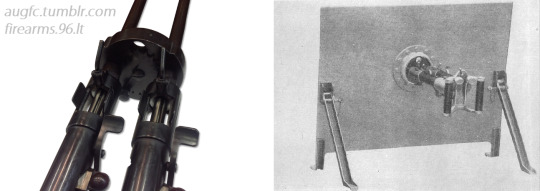
The circular sighting unit for the MBT Villar Perosa (left) and the shield mount it was designed to affix to (right). Villar Perosas with this sighting unit are NOT designed to be mounted to aircraft.

For comparison, an actual aerial-mounted Villar Perosa, fitted to a Voisin bomber via a single-strut stand with what appears to be a brass catcher underneath the twin ejection ports.
Orders for both the MBT and OVP Villar Perosas were placed in late 1915. The first guns were delivered in April 1916, of which 350 were made by OVP and issued to the Air Force, and 125 were made by MBT and issued to the infantry. By the end of the year, the Italian infantry had been issued 2,000 Villar Perosas, and this number ballooned to around 15,000 by 1918. The vast majority of weapons produced were MBT models for the infantry, and probably only a thousand or so were produced for the Air Force. This is why most Villar Perosas that survive today are infantry-issue models with circular mid-sections.
The distinction between the OVP (aerial service) and MBT (infantry service) Villar Perosas is shown below:
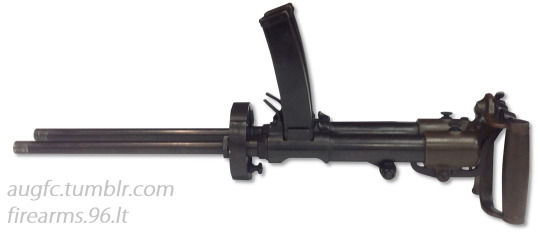
An infantry-service Villar Perosa: the most common type, of which around 15,000 were made. This model is distinguished by a central sighting unit in the shape of a circular disc, from which a shield is designed to mount. Produced by MBT.

An actual aerial-service Villar Perosa - mounted onto a flexible pintle, with elevated front and rear sights instead of a central sighting disc. Produced by OVP. (This example is in the British .455 Webley caliber, but a typical model would be in 9mm Glisenti with curved magazines.)
But the narrative about the Villar Perosa being designed exclusively as an aerial gun is so deeply entrenched that every once in a while, a collector gets their hands on an MBT Villar Perosa and is confused by the fact that there isn’t anywhere to mount the gun to a plane. Rather than resign themselves to the fact that these guns aren’t supposed to be fitted to aircraft (!!!), these people have, instead, stubbornly decided that the gun needs to be modified to fit an aircraft mount.
The first example I’ll show is an actual WW1-period modification, although not an Italian invention. The gun in these pictures is actually an MBT Villar Perosa that was captured by the Austrians and converted into an aerial-service weapon. As can be seen, a pivoting mount has been crudely bolted onto the sighting unit of the weapon, and the mount is affixed to the observation seat of a Phönix C.1 biplane. By late 1917, the Austrians began manufacturing their own copy of the Villar Perosa - known as the Sturm-Pistole - and therefore they stopped relying on captured Villar Perosas.
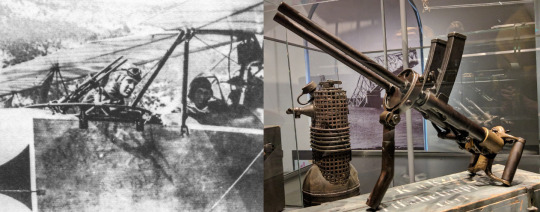
An Austrian-modified MBT Villar Perosa reconfigured into an aerial service weapon. Capturing an actual aerial service Villar Perosa would have been next to impossible, so the Austrians seem to have improvised with captured infantry models.
This example is currently held by the Heeresgeschichtliches Museum in Vienna. I note it here because, although it is contemporary with the war, it is not an “official” Villar Perosa mount and should not be mistaken for one.
The following contraption is passed off as a “reproduction” aerial mount for the Villar Perosa. It’s not really a repro, though, because no such mount really existed; it is, for all intents and purposes, a fantasy piece. This mount was made in the United States and has passed across several private collections, most recently being sold at Morphy’s in 2019.

The totally fictitious aerial mount for the MBT Villar Perosa, claimed to be a “reproduction”. Complete with a totally necessary aerial-service bipod, supported by thin air.
Essentially this is a pedestal-type stand with an adjustable gunner’s seat. The workmanship is admittedly quite impressive, with a series of pulleys which raise or lower the mount in accordance with the placement of the seat. But the main flaw is the attachment point to the gun itself. It uses a sort of vice-like contraption which is intended to clamp onto the circular mid-section of an MBT Villar Perosa. An MBT Villar Perosa doesn’t like it when you do this, because it’s not supposed to be fitted to an aircraft mount. As stated, actual aerial mounts for the Villar Perosa used a flexible pintle. Morphy’s claimed that this piece is “true to the original design”, but it’s completely made-up. Passing it off as a faithful reproduction of a real device is, in polite terms, misleading.
Finally… a really questionable attempt to bruteforce the MBT Villar Perosa into an aerial gun. This is the example in the collection of Bapty & Co., a British movie armourer.

No, this is NOT how a Villar Perosa should look. Unfortunately, this image gets passed off as a “standard” Villar Perosa quite often.
Similar to the previous mount, it seems that the owners of this gun were so convinced of this weapon’s apparent status as an aerial gun, yet so baffled by the lack of actual aerial mountings, that they decided to just invent their own. So they’ve devised an apparatus that clamps to both receivers and presumably acts as a connecting point for a flexible mount. Even more puzzlingly, an aerial front sight has been fixed to the barrels. This is completely unnecessary, as the circular unit of the MBT Villar Perosa has a self-contained sight post. This is one of the most inexplicable exercise in gun modification that I have ever seen, and it’s pretty baffling that at no point during the abuse of this gun did the owners realize that the “fixes” they were making were totally pointless. Thankfully, it seems to be non-permanent and completely reversible.
So there you have it. A lesson to future owners of Villar Perosas: if it doesn’t have an aerial mount, it’s not supposed to be fitted to a plane.
91 notes
·
View notes
Text
Rant: Fake Villar Perosa mounts
This is a bit of an odd topic. Readers are probably familiar with the twin-barreled Villar Perosa submachine gun, one of the very first SMGs ever produced. It was designed in around mid-1915 by Colonel Abiel Bethel Revelli, a Piedmontese ordnance officer in the Italian Army who developed the majority of Italy’s automatic weapons in the early 20th century. The Villar Perosa was a twin-barreled, magazine-fed, 9mm blowback machine-gun which incorporated many of the elements by which a submachine gun is defined, although it is often not considered a “true” submachine gun because of its inability to be fired from the shoulder. Combined with this, one reason people will often give for the Villar Perosa not being a real SMG is that it was “designed as an aircraft gun”.
The idea that the Villar Perosa was designed exclusively for aerial use, and was “adapted” into an infantry weapon later on in the war, is not entirely true. When the Villar Perosa was introduced into Italian service in late 1915, it was produced at two different plants - Officine di Villar Perosa (OVP) and Metallurgica Bresciana già Tempini (MBT). The OVP-made models were produced with a flexible pintle mount which was designed to affix to a stand of some kind, usually a tripod. Only these models could be fitted to aircraft. The MBT-made models were built with a large circular unit in the mid-section of the gun which featured a self-contained sighting post and peephole. The circular mid-section wasn’t just made like that because it looked cool, it was specifically designed to slot into a rectangular twin-legged shield mount for prone firing. This method of mounting was protected by Revelli’s patent of 24/09/1915 - this was before the weapon had actually been adopted and issued, thus proving that infantry use for the Villar Perosa was always a consideration since the very beginning and it was not “adapted” into an infantry weapon at a later date.

The circular sighting unit for the MBT Villar Perosa (left) and the shield mount it was designed to affix to (right). Villar Perosas with this sighting unit are NOT designed to be mounted to aircraft.

For comparison, an actual aerial-mounted Villar Perosa, fitted to a Voisin bomber via a single-strut stand with what appears to be a brass catcher underneath the twin ejection ports.
Orders for both the MBT and OVP Villar Perosas were placed in late 1915. The first guns were delivered in April 1916, of which 350 were made by OVP and issued to the Air Force, and 125 were made by MBT and issued to the infantry. By the end of the year, the Italian infantry had been issued 2,000 Villar Perosas, and this number ballooned to around 15,000 by 1918. The vast majority of weapons produced were MBT models for the infantry, and probably only a thousand or so were produced for the Air Force. This is why most Villar Perosas that survive today are infantry-issue models with circular mid-sections.
The distinction between the OVP (aerial service) and MBT (infantry service) Villar Perosas is shown below:

An infantry-service Villar Perosa: the most common type, of which around 15,000 were made. This model is distinguished by a central sighting unit in the shape of a circular disc, from which a shield is designed to mount. Produced by MBT.

An actual aerial-service Villar Perosa - mounted onto a flexible pintle, with elevated front and rear sights instead of a central sighting disc. Produced by OVP. (This example is in the British .455 Webley caliber, but a typical model would be in 9mm Glisenti with curved magazines.)
But the narrative about the Villar Perosa being designed exclusively as an aerial gun is so deeply entrenched that every once in a while, a collector gets their hands on an MBT Villar Perosa and is confused by the fact that there isn’t anywhere to mount the gun to a plane. Rather than resign themselves to the fact that these guns aren’t supposed to be fitted to aircraft (!!!), these people have, instead, stubbornly decided that the gun needs to be modified to fit an aircraft mount.
The first example I’ll show is an actual WW1-period modification, although not an Italian invention. The gun in these pictures is actually an MBT Villar Perosa that was captured by the Austrians and converted into an aerial-service weapon. As can be seen, a pivoting mount has been crudely bolted onto the sighting unit of the weapon, and the mount is affixed to the observation seat of a Phönix C.1 biplane. By late 1917, the Austrians began manufacturing their own copy of the Villar Perosa - known as the Sturm-Pistole - and therefore they stopped relying on captured Villar Perosas.

An Austrian-modified MBT Villar Perosa reconfigured into an aerial service weapon. Capturing an actual aerial service Villar Perosa would have been next to impossible, so the Austrians seem to have improvised with captured infantry models.
This example is currently held by the Heeresgeschichtliches Museum in Vienna. I note it here because, although it is contemporary with the war, it is not an “official” Villar Perosa mount and should not be mistaken for one.
The following contraption is passed off as a “reproduction” aerial mount for the Villar Perosa. It’s not really a repro, though, because no such mount really existed; it is, for all intents and purposes, a fantasy piece. This mount was made in the United States and has passed across several private collections, most recently being sold at Morphy’s in 2019.

The totally fictitious aerial mount for the MBT Villar Perosa, claimed to be a “reproduction”. Complete with a totally necessary aerial-service bipod, supported by thin air.
Essentially this is a pedestal-type stand with an adjustable gunner’s seat. The workmanship is admittedly quite impressive, with a series of pulleys which raise or lower the mount in accordance with the placement of the seat. But the main flaw is the attachment point to the gun itself. It uses a sort of vice-like contraption which is intended to clamp onto the circular mid-section of an MBT Villar Perosa. An MBT Villar Perosa doesn’t like it when you do this, because it’s not supposed to be fitted to an aircraft mount. As stated, actual aerial mounts for the Villar Perosa used a flexible pintle. Morphy’s claimed that this piece is “true to the original design”, but it’s completely made-up. Passing it off as a faithful reproduction of a real device is, in polite terms, misleading.
Finally... a really questionable attempt to bruteforce the MBT Villar Perosa into an aerial gun. This is the example in the collection of Bapty & Co., a British movie armourer.

No, this is NOT how a Villar Perosa should look. Unfortunately, this image gets passed off as a “standard” Villar Perosa quite often.
Similar to the previous mount, it seems that the owners of this gun were so convinced of this weapon’s apparent status as an aerial gun, yet so baffled by the lack of actual aerial mountings, that they decided to just invent their own. So they’ve devised an apparatus that clamps to both receivers and presumably acts as a connecting point for a flexible mount. Even more puzzlingly, an aerial front sight has been fixed to the barrels. This is completely unnecessary, as the circular unit of the MBT Villar Perosa has a self-contained sight post. This is one of the most inexplicable exercise in gun modification that I have ever seen, and it’s pretty baffling that at no point during the abuse of this gun did the owners realize that the "fixes” they were making were totally pointless. Thankfully, it seems to be non-permanent and completely reversible.
So there you have it. A lesson to future owners of Villar Perosas: if it doesn’t have an aerial mount, it’s not supposed to be fitted to a plane.
91 notes
·
View notes
Photo

The United Defence UD-1
The United Defence Supply Corporation was established in May 1941 to support the Allied war effort during World War II. They are best remembered for having designed the Marlin UD-42 submachine gun, but this was their first product, unveiled after the American entry into the war. It was a dual-caliber submachine gun chambered in both .45 ACP and 9x19mm Parabellum, with consideration for both the US Army and potential European users, such as resistance groups. Operationally it was a very basic straight-blowback gun with minimal furniture, designed to be as cheap as possible. The rudimentary "stock" was actually a spare 9mm barrel attached to a pivot, which could be switched out with the standard .45 barrel with ease. The gun fed from 20-round horizontally-fed magazines.
The UD-1 was submitted to the Aberdeen Proving Grounds for tests in April 1943 and went through only 180 rounds (.45 ACP) at a fire rate of 1150rpm. The tests were cut short when, during the mud tests, the gun completely failed to discharge. Representatives from United Defence attempted to remedy the problem by covering the barrel housing in masking tape to prevent mud getting in, but dirt still managed to seep in through the mag well and foul up the bolt. Unable to continue the tests, the UD-1 was rejected and the design was abandoned in favor of the more successful UD-42.
95 notes
·
View notes
Photo

LSA .276-caliber self-loading rifle
This experimental rifle was produced by the London Small Arms Co. in about 1909 - 1910, based on a patent by Thomas R. Ashton. It was chambered in the experimental .276 Enfield cartridge, which was pegged to replace .303 British but was ultimately shelved. The LSA rifle operated on a long-recoil action in which the breech block was engaged by a wedge in the rear interior of the receiver, forcing it to tip at an incline as the barrel recoils and the case ejects. The breech block would then straighten out as it recoiled forward again.
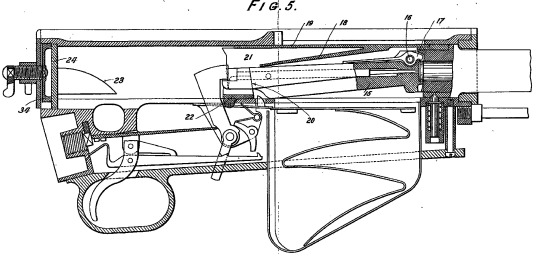
The gun fed from 10-round SMLE-type magazines, which were detachable, and there was no clip feed guide. The buttstock was also patterned after the SMLE; perhaps unsurprising as LSA were a manufacturer of the SMLE. In any case, the LSA rifle fared poorly in tests, particularly in harsh conditions, and was not considered suitable for military service.
85 notes
·
View notes
Note
Jp Foote mg69 belt fed machine gun. So far I've only been able to find that it was made only as a prototype. I'd like to find some more information on this gun. I purchased it at an estate auction mainly as a conversation piece but the more I look over it, it appears to be in working order. I've thoroughly cleaned and oiled it and the action appears to work perfectly along with the feed mechanism. Thanks for any info


No idea how late this response is, but the MG69 was designed by John P. Foote in the late 1960s (I believe he’s still alive). He was negotiating a deal to get this gun and an assault rifle he designed (the FAC-70) into production at Sterling Armaments in Britain. However Sterling were approached by ArmaLite to produce the AR-18 and therefore rejected Foote’s offer.
According to Thomas Nelson, the MG69 feeds from standard M13 NATO belt links through the underside of the receiver (I assume you already have some idea of how the gun operates).
J.P. Foote designed a lot of weapons during his career, which were all ubiquitously inexpensive and extremely simplistic. Probably his most famous (or notorious) design was the Cobray Terminator shotgun.
Here are some links that you might find useful:
https://www.smallarmsreview.com/display.article.cfm?idarticles=279
http://www.helstonforensics.com/wp-content/uploads/2018/03/foote-carbine-machine-gun-18310.pdf
30 notes
·
View notes
Text
Bergmann submachine gun variants
The Bergmann M.P.18,I submachine gun is widely considered to have been the first successful submachine gun, and as a consequence many variants of the design were made. This post covers the main derivatives of the Bergmann submachine gun which retained the basic elements of the design (variants like the Schmeisser M.K.36,III and Haenel MP41 are excluded for deviating too far from the original M.P.18,I).

Comparison of the various types of Bergmann magazine feed - M.P.18,I on the left; M.P.18,I police issue/M.P.28,II in the center; and SIG-Bergmann on the right.
The Bergmann M.P.18,I (military issue)

The original production version of the Bergmann M.P.18,I submachine gun was developed in 1918 by Hugo Schmeisser, then-employed by Theodor Bergmann. It operated on a basic blowback action upon which the bolt rode on a spring-loaded guide rod, and employed a canted magazine feed, taking the 32-round “Trommelmagazin” originally designed for the Artillery Luger carbine. The M.P.18,I had fired only in full-auto and had no mechanical safety whatsoever; the only safety provision was a catch in the cocking slot which could be used to manually hold the bolt in the rearward position. The gun was chambered in the standard German pistol cartridge, 9x19mm Parabellum.
The M.P.18,I was adopted by the German Army and first issued during the Summer of 1918, seeing some combat use during the later stages of World War I. It is estimated that some 35,000 M.P.18,Is were produced in total, although only a few thousand were actually issued during the war and the vast majority of examples were probably produced after the Armistice. Production lasted from 1918 - 1920.
It is often said that the M.P.18,I made such an impact on Allied troops that it was specifically singled out in the Treaty of Versailles. This is not actually true; submachine guns like the M.P.18,I actually fell under the rather ambiguous category of “light machine guns” and “automatic rifles”, and are never actually mentioned by name in the Treaty. Actual primary sources from the wartime period indicate that the M.P.18,I was not particularly valued by Allied authorities.
The Bergmann M.P.18,I (police issue)

After the enforcement of the Treaty of Versailles, the German Army was subjected to severe restrictions on the number of automatic weapons and machine guns that they were allowed to issue, and as a consequence the M.P.18,I was retracted from service. Some came into circulation with veteran’s militias like the Freikorps, although the vast majority were simply pressed into service with the German police, at a rate of about 1 gun per 20 men.
Schmeisser, now working at C.G. Haenel, continued to make improvements to the design after World War I and in 1920 he developed a new type of magazine feed for the M.P.18,I that would take straight box magazines of 32 or 20 rounds. On behalf of the German police, a large quantity of M.P.18,I submachine guns were converted to this new system by Haenel during the 1920s.
Police-issue M.P.18,Is are also often fitted with a safety switch on the forward receiver, which locks the bolt in place when flipped. These are the same type of safety switches that are commonly seen examples of the Erma EMP submachine gun.
The SIG-Bergmann Model 1920

Waffenfabrik Bergmann was one of many German armaments manufacturers that was closed after the enforcement of the Treaty of Versailles in 1920. Production of the M.P.18,I in Germany therefore came to an end, but Theodor Bergmann wanted to continue promoting the weapon and therefore sold the production rights to SIG in Switzerland, where manufacture could go ahead without running foul of the Versailles restrictions.
The SIG-Bergmann submachine was not, however, a straight copy of the Bergmann M.P.18,I. It featured several modifications made in-house at SIG, including a proprietary type of magazine feed taking 50-round straight box magazines. This feed was distinct from the Schmeisser-type straight feed, with the magazine catch being placed on the underside of the housing, and it could not take Schmeisser magazines.
Several other detail modifications were also made to the design. The fixed notch sights of the M.P.18,I were replaced by an adjustable tangent graduating to 1,000 meters. The cocking handle was a rounded knob rather than a curved lever, and the bolt lugs were added to the barrel collar. The SIG-Bergmann was not chambered in 9x19mm Parabellum, but instead only offered in 7.65mm Parabellum and 7.63mm Mauser.
The SIG-Bergmann submachine gun saw limited use by the Swiss Army and was also offered for export, with significant sales to Finland (in 7.65mm), China, and Japan (both in 7.63mm). It was used extensively in China in the 1930s and 40s, and was adopted by the Imperial Japanese Navy as the Type Be (”Be” for “Beruguman”). Production of the SIG-Bergmann lasted from 1920 - 1927, although it continued to be sold into the early 1930s.
The Tallinn Arsenal M/23

From 1923 - 1930, an unlicensed copy of the SIG-Bergmann submachine gun was produced in Estonia by Tallinn Arsenal. This gun, known as the Model 1923 or M/23, was probably based on Finnish examples of the SIG-Bergmann. The M/23 was designed by Johannes Teiman and was constructed from original components, making it visually distinct from other Bergmann variants, particularly in its distinctive stock design and rectangular barrel vents. The M/23 took 40-round box magazines and was chambered in 9x20mm Browning Long, a rare cartridge for SMGs.
It is estimated that only about 570 Tallinn Arsenal M/23 submachine guns were produced, and the majority of these were later sold off to the Spanish Republic during the Spanish Civil War (1936 - 1939). Some examples were captured and used by the Italian CTV (Corpo Truppe Volontarie) during this conflict.
The Tsing Tao & Dagu Arsenal SMGs
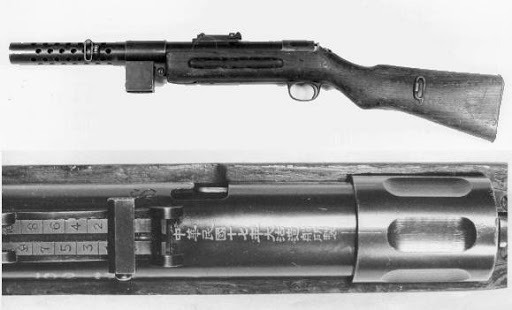
Following the sale of SIG-Bergmann submachine guns to China in the 1920s, domestic copies of the design began to be produced at various factories, the primary manufacturers being the Tsing Tao Naval Arsenal and the Dagu Arsenal. The Chinese Bergmann was a straight copy of the SIG-Bergmann with the magazine housing rotated to a vertical feed rather than a horizontal feed; otherwise the design was essentially unchanged, and all the elements that distinguish the SIG-Bergmann from the M.P.18,I can be seen on the Chinese Bergmanns. The same long, 50-round magazines were used, making the Chinese copies awkward to use from a prone position.
The Tsing Tao & Dagu submachine guns were produced in relatively large quantities and used extensively during the Chinese Civil Wars and the Sino-Japanese War. It should also be noted that some Chinese Bergmanns were produced without the vertical magazine, and are basically identical to the original SIG-Bergmann except for the markings.
The production dates of the Chinese Bergmann copies are impossible to pin down, as manufacture was decentralized across many different factories. However, it is likely that several thousand were produced during the interwar years.
The Haenel M.P.28,II

Throughout the 1920s, Schmeisser made further improvements to the M.P.18,I, culminating in 1928 with the development of the successor to the Bergmann, the M.P.28,II. This gun was based on the police-issue M.P.18,I but included several new features, most notably a cross-bolt fire selector and safety button placed above the trigger group. This is the feature from which the M.P.28,II is instantly identifiable from other Bergmann derivatives. The M.P.28,II also replaced the old M.P.18,I bolt with an entirely new type, with a separate firing pin. The new bolt travelled freely in the receiver against a wide diameter recoil spring, instead of riding on a spring-loaded guide rod. The M.P.28,II also had adjustable tangent sights similar to the SIG-Bergmann.
The M.P.28,II was produced at C.G. Haenel and was chambered in 9x19mm Parabellum by standard, but was also offered in a variety of calibers for export, including 9x25mm Mauser, 7.65mm Parabellum, and even .45 ACP. It was sold to Belgium, Bolivia, the Netherlands, Portugal, and Romania, among many other countries. In Germany, it was used by police forces and various paramilitary factions, including the Waffen-SS, but was never adopted by the Wehrmacht. Production lasted from 1928 - 1940, whereupon it was succeeded by the MP41 submachine gun, which utilized some components from the M.P.28,II.
The Bayard Mi34

In 1934, the M.P.28,II was adopted by the Belgian Army and it was produced under license by Anciens Etablissements Pieper, trading under the name “Bayard”. This gun, known in Belgian service as the Mi34 Schmeisser-Bayard, was identical in most aspects to the original M.P.28,II and differed only in the manufacturer’s markings and the redesign of the bolt handle from a curved lever to a long, straight handle with a rounded knob on the end, somewhat similar to that seen on the SIG-Bergmann. The Bayard Mi34 was produced from 1934 - 1940.
The “Naranjero”

The so-called “Naranjero” was an unlicensed copy of the M.P.28,II produced in Spain during the Spanish Civil War (1936 - 1939) by Republican factories in Valencia; it apparently gained its name from the orange trees that grew around the city. This variant was basically a straight clone of the M.P.28,II except for the bolt, which was made from brass and featured a distinctive, oversized, circular cocking handle. These bolts were weaker than the original steel bolts of the M.P.28,II. On some examples, the magazine housing is also made from brass. A bayonet catch was also added to the underside of the barrel jacket.
The Naranjero was produced from about 1937 - 1939. Total production figures are unknown but were probably in the low thousands. It has been speculated that the British copy of the M.P.28,II - the Lanchester - was actually based on a Naranjero submachine gun from Spain, although this is difficult to prove.
The Lanchester Mk.I

In 1940, after years of inaction regarding the adoption of a submachine gun, the British government finally decided that a domestically-manufactured SMG was required. Initially the Royal Air Force requested a copy of the German MP38, but it was decided to instead produce a copy of the more expensive M.P.28,II - the logic behind this decision is not really clear. The design of this copy was handled by George Herbert Lanchester of the Sterling Armaments Company and the final production gun was named after him. It was adopted by the RAF and the Royal Navy for the protection of airstrips and naval vessels, but was not adopted by the Army, who were set on the cheaper Sten gun.
Despite being a copy of the M.P.28,II, the Lanchester Mk.I used no parts from the German gun and deviated in some elements of the design. The fire selector/safety switch was relocated to forward of the trigger group and the disassembly catch was placed on the rear receiver, behind the end cap. Proprietary 50-round magazines were used and a bayonet catch was fitted to the barrel. All in all, it may have ended up being more expensive to produce than the M.P.28,II. This was addressed to an extent with the introduction of a simplified variant in 1941, known as the Lanchester Mk.I*, which replaced the rear tangent sight with a basic flip-notch and saw the total removal of the fire selector, giving only fully-automatic fire. From 1942, many Mk.I Lanchesters had their fire selectors removed and their trigger mechanisms simplified.
The Lanchester was only in production during the war years and saw little actual use in combat. Just short of 100,000 were produced in total and it officially remained in Naval service until 1960, whereupon it was finally declared obsolete, although some examples remained aboard British vessels until the 1970s.
117 notes
·
View notes
Photo


Seizure of automatic weapons in France, 1938
These photos were taken during the aftermath of a police raid on an arms cache owned by the French fascist movement La Cagoule in October 1938. Among the weapons that were discovered in this large cache were quantities of Bergmann M.P.35/I and Haenel M.P.28,II submachine guns, Beretta Mod.1918/30 carbines, Hotchkiss Model 1926 and Châtellerault FM24/29 machine guns, and hunting shotguns. The Bergmann and Haenel SMGs were almost certainly supplied by the Nazis; German-made SMGs also cropped up in the hands of fascist groups in Czechoslovakia around the same time.
The Beretta carbines are a little more interesting. These guns were updated versions of the old Beretta Mod.1918 automatic carbine produced during the latter months of World War I. The Italian government seems to have sold quantities of both the Mod.1918 and the Mod.1918/30 to Ethiopia, Argentina, and Saudi Arabia in the 1930s, however these were mostly commercial sales, whereas the examples that were supplied to La Cagoule were probably donated for political reasons.
151 notes
·
View notes
Note
Hey there, how goes it? Ive been reading your posts for many years. What happened with your blog? Is it compleatly dead or you are going to carry with it on later? And yeasss many thanks, you did a great job. Best wishes, Evan O
I’m mostly focusing these days on writing for my website firearms.96.lt or posting on r/ForgottenWeapons under u/Get_Em_Puppy. I’ll still try to post the occasional thing on here though. Apologies if this is a late reply.
9 notes
·
View notes
Text
The Puckle gun gets roasted in 18th century verse

Recently I learned of a set of playing cards made in the 1720s by Thomas Carrington Bowles of London. These cards, billed “Bubble Cards”, satirize contemporary economic bubbles of the day, in particular the infamous South Sea Trading Company which single-handedly ruined countless investors. But, to my surprise, also mocked in these cards is the Puckle gun, and the sorry state of affairs that surrounded it.
By now, the story of the ill-fated Puckle gun should be familiar to most readers. This flintlock cannon, invented by the English lawyer James Puckle in 1717, was revolutionary in its day insofar as it fired from a series of revolving chambers. It is often cited as a conceptual predecessor of the machine-gun, although it was not automatic and still relied on manual operation. Regardless, it mustered a significantly higher rate of fire than typical muskets of the day, capable of firing off nine shots in the time it might take a rifleman to fire two. Notoriously, the gun was marketed with the option to chamber square projectiles (which would cause more grievous wounds) specifically for against “heathen” Turks, a feature which Puckle clearly considered would appeal to zealous protestants of whom there was no short supply in England at the time.
The Puckle gun attracted considerable interest from speculators, who were taken in by the idea that it would revolutionize firearms. What it failed to impress, however, was the one organization upon which its entire value relied upon - the British Army. It was demonstrated before military officials, firing 63 shots in seven minutes, but despite an impressive display the Army expressed no interest in adopting it. In fact, the only known sales came in 1722 when the Duke of Montagu privately purchased two to accompany him during his ill-fated attempt to conquer the Caribbean islands of St. Lucia and St. Vincent. With no other sales forthcoming, the Puckle Machine Company went bust and its investors lost considerable sums of money, as satirized in this playing card.
An illustration printed onto the card depicts the gun - an oversized, but surprisingly accurate rendition - cutting down not sabre-wielding Turks, but tricorn-clad Englishmen who are representative of Puckle’s investors. Below this illustration is a short verse:
“A rare invention to destroy the crowd
of fools at home instead of fool abroad.
Fear not, my friends, this terrible machine,
they're only wounded who have shares therein.”
222 notes
·
View notes
Photo
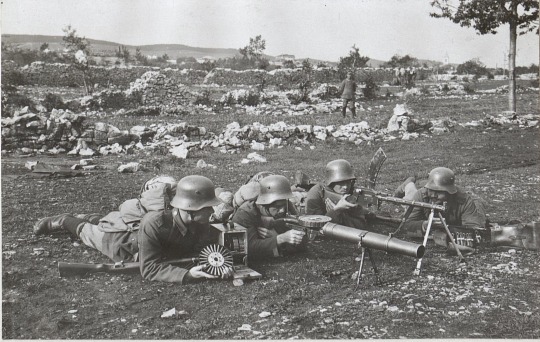


German “Muskete” section on the Italian Front, 1917
1917 marked the year that the Eastern Front of the Great War came to an end. With Russia now at peace with Germany and Austria-Hungary, troops stationed in the East could be sent to reinforce divisions on the other fronts. While the fighting in France raged on, and was unlikely to end any time soon, the Central Powers saw their renewed manpower as an opportunity to knock the Italians - isolated from their allies - out of the war. The war on the Italian Front had been ongoing since May 1915 and, despite no less than 11 back-and-forth offensives along the Isonzo River, it had seen little ground gained or lost by either side.
The Austrians, who had largely been fighting a defensive war against the Italians, planned a large-scale offensive, utilizing new “Storm Trooper” tactics. Germany agreed to send 7 divisions of troops to assist in the Austrian offensive, which was launched on the 24th of October. It was a devastating victory for the Austro-German forces, pushing the Italians all the way back to the Piave river and decimating the brunt of their forces. Some 200,000 Italians were captured and thousands deserted.
These photos were taken just before the Caporetto offensive and depict a group of German troops who had been sent to reinforce the Austrians. The selection of weapons in these photos are interesting, as non of them are typical of German wartime issue. The machine-gunners are armed with Danish Madsen guns, which were referred to by the Germans as “Musketes”. Only limited quantities of this gun were purchased by the German Army and it is rare to see them in use - especially with the accompanying leather pouch for spare magazines. One of the machine-gunners is even armed with a British Lewis gun, probably a souvenir from the Western Front, complete with a wooden crate for storing several flat-pan magazines. In addition, the riflemen, who are acting as loaders for the machine-gunners, are equipped with the scarce Kar98a carbine rather than the standard-issue Gewehr 98.
Also shown in a photo is a rather unwieldy wooden cart which acts as a mode of transportation for the “Musketes” and their ammunition. Apparently, a similar cart was initially issued with the M.P.18,I submachine gun when that came into service. The soldiers can also be seen to be carrying C96 pistols and hand-grenades, indicating that they are perhaps Sturmtruppen - this would seem to fit with the choice of weaponry, as light machine guns and carbines were favoured among assault troops.
The Austro-Hungarians also made use of light automatic weapons at Caporetto. They too had purchased small quantities of Madsen guns, in 8x50mmR, and just a few days prior to the offensive they received a 9x23mm submachine gun known as the “Sturmpistole”, which was a reverse-engineered copy of the Italian Villar Perosa. Both were fielded by Austrian Sturmbataillons during the offensive.
Paradoxically, the success of the Caporetto offensive proved to be Austria-Hungary’s undoing in the long run. So much ground was gained that supply lines were stretched thin and a follow-up offensive in mid-1918 floundered. Conversely, the Italian Army only got stronger. The threat of invasion from the Austrians promoted national unity in Italy, with recruitment and morale at an all-time high. Incompetent elements of the Italian General Staff were fired and replaced, and reinforcements were sent from Britain, France, and the United States. When the Italians hit back on the 24th of October 1918, the anniversary of the Caporetto offensive, they found the Austro-Hungarian Army in a state of total decay, and by the time they surrendered on the 4th of November, the Hapsburg Empire had completely collapsed.
49 notes
·
View notes
Photo
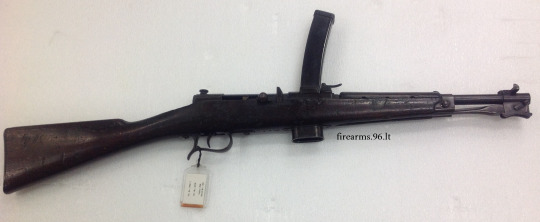

Not actually an SMG: the Beretta Model 1918 automatic carbine
In 1916 the Italian Test Commission observed the demonstration of a new weapon, the Fiat, which was a single-barreled, shoulder-fired adaptation of the Villar Perosa submachine gun. The potential of this weapon was of some interest to the Italian Army and a trial to compare various different SMGs was arranged. Several companies, all involved in the production of the Villar Perosa, were commissioned to develop their own take on the submachine gun concept.
The companies that submitted entries in 1918 were Fiat (as mentioned), Ansaldo, and Beretta. An additional SMG was developed privately by Amerigo Cei-Rigotti but the details are few and far between. Beretta’s submission was designed by the self-taught engineer Tullio Marengoni, and was constructed from the receiver of a Villar Perosa, the stock of a Vetterli rifle, and the folding bayonet of a Carcano M91 carbine. The trigger mechanism was overhauled from the Villar Perosa and this leads to an interesting point that is ubiquitously overlooked: the Beretta Model 1918 was not actually a submachine gun.
The Villar Perosa’s “triggers” were simple; a pair of long levers that extended from the spade grips to the receiver which, when pressed down, would hold the trigger sears and allow the twin bolts to reciprocate repeatedly. In the more conventional trigger of the Beretta, the sear does not stay down when the trigger is pulled thanks to a disconnector. Therefore, the gun will only fire with each pull of the trigger, in the typical semi-automatic fashion.
Otherwise, the action of the gun is basically unchanged from the Villar Perosa. It operates on a delayed-blowback principle in which the bolt’s travel is impeded by a 45-degree incline in the bolt path, which forces the bolt to rotate every time it comes forward. The magazine feed is also of the same type, taking the standard 25-round Villar Perosa magazines in an overhead feed. Due to the placement of the magazine, the iron sights are offset; however they are not mounted on the left side of the receiver as one might expect, but on the right. This may sound impractical, but with your cheek pressed against the stock, the sights are actually well within your line-of-sight.

Rare twin-trigger variant of the Beretta Model 1918. This was not issued.
A number of variants of the Beretta Model 1918 were developed, including a twin-trigger model, a selective-fire variation, and a version with an inverted magazine feed (taking magazines from the bottom). But the variant that was adopted by the Italian Army in 1918 was certainly the single-trigger, semi-automatic version (pictured). It was selected over the competing entrants and an order for 25,000 units was placed; however, World War I ended before the weapon could be issued on a large scale, and the order was cancelled in 1920 after only some 5,000 had been delivered. The performance of the Beretta was further evaluated in the years immediately following the war and the Italian Army came to the decision that the 9mm Glisenti cartridge, for which it was chambered, was too weak. A programme to develop an intermediate rifle cartridge - 7.35x32mm - and an accompanying selective-fire rifle - the Terni Model 1921 - to replace the Beretta, showed great promise but was cancelled in 1928 after only 200 Terni rifles had been made.
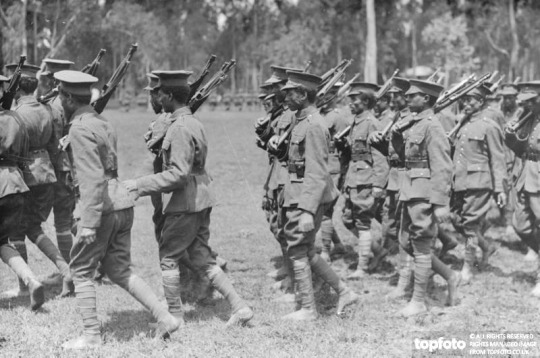
Ethiopian infantry march with Beretta Model 1918s over their shoulders. (Image from topfoto.co.uk)
In 1930, some of the existing Beretta Model 1918s were refurbished into improved variants known as the Model 1918/30. This featured a new underloading magazine feed and receiver. The Model 1918/30 is sometimes claimed to have been a semi-automatic conversion of the Model 1918, but as pointed out, this is not the case, since the original Model 1918 was never fully-automatic to begin with and there was thus no “converting” to be done.
The Beretta Model 1918 (officially the Revelli-Beretta in Italian service) was never produced on a large scale, but did see its fair share of action. While data on its use in World War I remains sketchy (secondary sources from the interwar era attest that it was used, but in a similar fashion to the French R.S.C. rather than the German M.P.18,I), it is definitely known to have been used during the Italo-Ethiopian War of 1935 and the North African campaign of World War II. In fact, just earlier this year, a long-abandoned stockpile of Beretta Model 1918s was discovered in Ethiopia. The gun was used by both the Ethiopian Army and the Italians.
65 notes
·
View notes